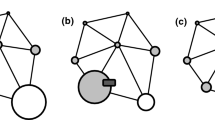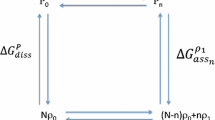Abstract
Cooperative binding has been described in many publications and has been related to or defined by several different properties of the binding behavior of the ligand to the target molecule. In addition to the commonly used Hill coefficient, other characteristics such as a sigmoidal shape of the overall titration curve in a linear plot, a change of ligand affinity of the other binding sites when a site of the target molecule becomes occupied, or complex roots of the binding polynomial have been used to define or to quantify cooperative binding. In this work, we analyze how the different properties are related in the most general model for binding curves based on the grand canonical partition function and present several examples which highlight differences between the cooperativity characterizing properties which are discussed. Our results mainly show that among the presented definitions there are not two which fully coincide. Moreover, this work poses the question whether it can make sense to distinguish between positive and negative cooperativity based on the macroscopic binding isotherm only. This article shall emphasize that scientists who investigate cooperative effects in biological systems could help avoiding misunderstandings by stating clearly which kind of cooperativity they discuss.








Similar content being viewed by others
References
Abeliovich H (2005) An empirical extremum principle for the Hill coefficient in ligand-protein interactions showing negative cooperativity. Biophys J 89(1):76-79
Adair GS et al (1925) The hemoglobin system VI. The oxygen dissociation curve of hemoglobin. J Biol Chem 63(2):529-545
Alvarado D, Klein DE, Lemmon MA (2010) Structural basis for negative cooperativity in growth factor binding to an EGF receptor. Cell 142(4):568-579
Ben-Naim A (2001) Cooperativity and regulation in biochemical processes. Kluwer Academic/Plenum Publishers, Dordrecht
Berg J, Tymoczko J, Stryer L (2007) Biochemistry. W. H. Freeman, New York
Bush EC, Clark AE, DeBoever CM, Haynes LE, Hussain S, Ma S, McDermott MM, Novak AM, Wentworth JS (2012) Modeling the role of negative cooperativity in metabolic regulation and homeostasis. PloS One 7(11):e48920
Erion TV, Strobel SA (2011) Identification of a tertiary interaction important for cooperative ligand binding by the glycine riboswitch. RNA 17(1):74-84
Ge H, Qian M (2009) Theoretical analysis of the relationship between positive/negative cooperativity and enzyme activation/inhibition. Interdiscip Sci Comput Life Sci 1(3):204-213
Gutierrez PS, Monteoliva D, Diambra L (2012) Cooperative binding of transcription factors promotes bimodal gene expression response. PLoS One 7:e44812
Hasselbalch K (1916) Die Berechnung der Wasserstoffzahl des Blutes aus der freien und gebundenen Kohlensäure desselben, und die Sauerstoffbindung des Blutes als Funktion der Wasserstoffzahl. Julius Springer, Berlin
Henderson LJ (1913) The fitness of the environment. Macmillan, New York
Hill AV (1910) The possible effects of the aggregation of the molecules of haemoglobin on its dissociation curves. J Physiol 40:vi-vii
Hill AV (1913) The combinations of haemoglobin with oxygen and with carbon monoxide. I. Biochem J 7(5):471
Hill T (1985) Cooperativity theory in biochemistry
Hunter CA, Anderson HL (2009) What is cooperativity? Angew Chem Int Ed 48(41):7488-7499
Kaczanowska K, Harel M, Radić Z, Changeux J-P, Finn M, Taylor P (2014) Structural basis for cooperative interactions of substituted 2-aminopyrimidines with the acetylcholine binding protein. Proc Natl Acad Sci 111(29):10749-10754
Martini JWR (2014) Excursions in the theory of ligand binding
Martini JWR, Habeck M (2015) Comparison of the kinetics of different markov models for ligand binding under varying conditions. J Chem Phys 142(9):094104
Martini JWR, Ullmann GM (2013) A mathematical view on the decoupled sites representation. J Math Biol 66(3):477-503
Martini JWR, Habeck M, Schlather M (2013a) A derivation of the grand canonical partition function for systems with a finite number of binding sites using a Markov chain model for the dynamics of single molecules. J Math Chem
Martini JWR, Schlather M, Ullmann GM (2013b) The meaning of the decoupled sites representation in terms of statistical mechanics and stochastics. MATCH Commun Math Comput Chem 70(3):829-850
Onufriev A, Ullmann GM (2004) Decomposing complex cooperative ligand binding into simple components: connections between microscopic and macroscopic models. J Phys Chem B 108(30):11157-11169
Onufriev A, Case DA, Ullmann GM (2001) A novel view of pH titration in biomolecules. Biochemistry 40(12):3413-3419
Schellman JA (1975) Macromolecular binding. Biopolymers 14:999-1018
Stefan M I, Le Novère N (2013, 06) Cooperative binding. PLoS Computat Biol 9(6):e1003106
Ullmann RT, Ullmann GM (2011) Coupling of protonation, reduction and conformational change in azurin from Pseudomonas aeruginosa investigated with free energy measures of cooperativity. J Phys Chem B 115:10346-10359
Weisstein EW (2002) CRC concise encyclopedia of mathematics. CRC Press, London
Acknowledgments
L.D. is a researcher of CONICET (Argentina). J.W.R.M. would like to thank Mareike Busmann for helpful discussions. Moreover, we would like to thank our unknown reviewers for constructive suggestions.
Author information
Authors and Affiliations
Corresponding author
Rights and permissions
About this article
Cite this article
Martini, J.W.R., Diambra, L. & Habeck, M. Cooperative binding: a multiple personality. J. Math. Biol. 72, 1747–1774 (2016). https://doi.org/10.1007/s00285-015-0922-z
Received:
Revised:
Published:
Issue Date:
DOI: https://doi.org/10.1007/s00285-015-0922-z




